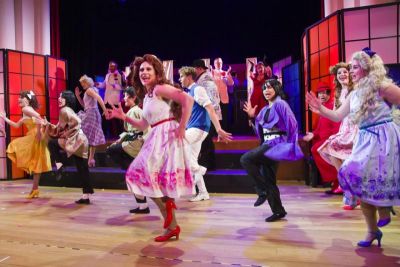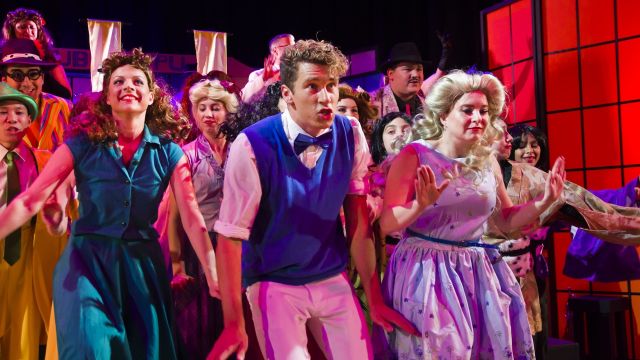Hot Mikado
Gilbert and Sullivan’s satirical comic opera The Mikado has always been quintessentially British, despite being dressed up in Japanese costumes, festooned with lanterns and screens and peopled by characters with cod-Japanese names.
Not so much in this version! Inspired by the 1939 Afro American Broadway version The Hot Mikado, the original comic opera songs in this 1986 version now have jazz, swing, gospel and torch interpretations and harmonies, while the costuming is a mix of Japanese and 1940s American.
Trimmed of several songs and quite a bit of dialogue, Hot Mikado remains true to the original plot but there’s less satirical edge in what is really more a snappy, light-hearted musical comedy romp, with its influences from vaudeville to Cotton Club, plus sly little digs at G & S tradition on the side.
The titular Mikado’s big number, for instance, becomes a tap-dancing extravaganza with the lyrics taking a decided second place.
Declan Moore’s deft and daffy direction, and his share in the in-on-the-joke choreography (with Stephanie Edmonds), ensure that the laughs flow all night.
 David Verdejo’s vaudevillian Ko-Ko milks the laughs for all they’re worth from go to whoa. Blake Lovely (Nanki-Poo) and Nina Marsh (Yum-Yum) play their romantic coupling charmingly, though Marsh makes the stronger vocal contribution of the pair. Alisia Jedrzejczak’s vocal oomph and vivacious characterisation make her Pitti-Sing a stand-out, while Rachel Hertz rounds out the Andrews Sisters styling of the ‘Three Little Maids’ effectively. Tisha Kelemen’s la®ger-than-life gender-switched Mikado is a forbidding presence. Rachel Gillfeather’s imposing Katisha puts a Mae West-ish spin on the role, weighing in with a smokin’ torchy vocal. Eamon Moses’ Pish Tush and Karen Oliver’s Pooh-Bah (cast against gender) are effective as the corrupt local officials.
David Verdejo’s vaudevillian Ko-Ko milks the laughs for all they’re worth from go to whoa. Blake Lovely (Nanki-Poo) and Nina Marsh (Yum-Yum) play their romantic coupling charmingly, though Marsh makes the stronger vocal contribution of the pair. Alisia Jedrzejczak’s vocal oomph and vivacious characterisation make her Pitti-Sing a stand-out, while Rachel Hertz rounds out the Andrews Sisters styling of the ‘Three Little Maids’ effectively. Tisha Kelemen’s la®ger-than-life gender-switched Mikado is a forbidding presence. Rachel Gillfeather’s imposing Katisha puts a Mae West-ish spin on the role, weighing in with a smokin’ torchy vocal. Eamon Moses’ Pish Tush and Karen Oliver’s Pooh-Bah (cast against gender) are effective as the corrupt local officials.
A small ensemble of singers and dancers, including a 1940s style vocal quartet attacked their work with great verve, contributing in no small part to the evening’s entertainment.
The Independent Theatre can be an awkward space, but here there is clever staging across several levels, with the band in a Cotton Club styled setting on the main stage, then broad steps to the lower main apron stage area where most of the action takes place. The relatively simple design relies mostly on moveable Japanese screens.
Costuming and wigs are an attractive mix of American swing era and traditional Japanese.
A swinging six-piece on-stage musical combo led by Andrew Bartle ensures that the musical score is delivered in style.
 From shortly after its debut in 1885, Gilbert and Sullivan’s greatest London hit in its day saw unauthorized productions mushrooming around the world.
From shortly after its debut in 1885, Gilbert and Sullivan’s greatest London hit in its day saw unauthorized productions mushrooming around the world.
Though copyright laws meant we, like the Brits, essentially saw ‘traditional’ versions into the 1960s, elsewhere, particularly in America, The Mikado was instantly open to other (sometimes multiple and simultaneous) interpretations including burlesque send-ups.
In 1939, The Swing Mikado (1938) and The Hot Mikado competed for audiences directly across the street from each other on Broadway. There were TV versions, with one starring Groucho Marx and another, The Cool Mikado, adapting the music to a 1960s sound with a Japanese gangster plot. There was also The Back Mikado, a jazzy Caribbean version, and The Jazz Mikado in 1920s Berlin.
From the 1960s onward, it has become open slather internationally.
While variations like Hot Mikado may not be please the shrinking ranks of G & S traditionalists, this lively, happy production delighted a mostly younger audience on opening night. It’s well worth a visit to North Sydney.
Neil Litchfield
Photographer: Alan Roy
Subscribe to our E-Newsletter, buy our latest print edition or find a Performing Arts book at Book Nook.

